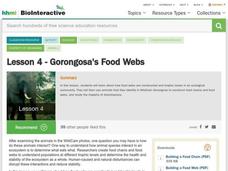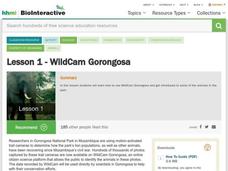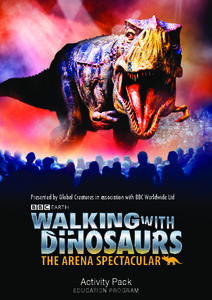National Park Service
News Bearly Fit to Print
There are an average of three human fatalities by bears in North America every year, which is low when you compare it to the 26 killed by dogs and the 90 killed by lightning annually. The lesson encourages researching human-bear...
American Museum of Natural History
Super Teeth
A brief comparison of human teeth versus animal teeth sets the stage for two worksheets. Scholars match a picture of a tooth-filled mouth to the animal to which it belongs and coloring pages featuring a different animal and informative...
Howard Hughes Medical Institute
Lesson 4: Gorongosa's Food Webs
Who eats who in the savannas of Africa? Explore trophic levels with part four of an eight-part series of lessons focused around Gorongosa National Park. After young explorers identify animals using trailcam images, they construct a food...
Howard Hughes Medical Institute
Lesson 1: WildCam Gorongosa
Take a walk on the wild side! Episode one of an eight-part series of interactive lessons regarding Gorongosa National Park invites learners to become a part of the citizen science community. Scholars read a brief overview of the trail...
Howard Hughes Medical Institute
Niche Partitioning and DNA Metabarcoding
What is DNA metabarcoding? Show your biology class the latest method for studying biodiversity in an ecosystem with a fun, informative interactive. Individuals examine the animal species that compete for vegetation, then learn how their...
Science 4 Inquiry
At the Top: A Bald Eagle's Diet
Bald eagles are opportunistic predators and eat fish as well as raccoons and other mammals. Pupils learn about bald eagle diets through a simple simulation and videos. They collect and analyze data to understand the adaptability of this...
BBC
Walking with Dinosaurs
Breath new life into your class's study of dinosaurs with this extensive collection of materials. Offering everything from a printable T-rex mask, word searches, and connect-the-dots activities to informational handouts, hands-on...
Curated OER
Food Chain Game
Learners explore animal characteristics by participating in a role-play activity. In this food chain lesson, students discuss the order of life and how animals must eat other animals to survive. Learners conduct a food chain game in...
Curated OER
Teeth and Eating
Young scholars examine pictures of different animals and decide if they eat meat and/or plants. They inspect models of pairs of upper and lower teeth and discuss which teeth are most useful for cutting grass and tearing meat.
Curated OER
Teeth and Eating
Students conduct online research of different animals and their diet. In this animal instructional activity, students identify the various types of diets each animals has and their teeth. This research is done on the Internet.
Curated OER
Animals and Their Food
In this animal food matching worksheet, students draw a line from the cow, giraffe, and bird to the food picture that goes with it in another column.
Curated OER
Teeth and Eating
Students explore animal diets and teeth. In this animal science lesson, students view photos of animals and their teeth. Students identify the type of diet the animal has based on the teeth. Students are introduced to the terms...
Curated OER
What Do Animals Eat?
In this animal diets worksheet, students identify animals and food. Students then draw a line to the food that the 4 animals eat.
Curated OER
Mazes: Which Animal Ate this Twig?
In this logic and problem solving worksheet, learners find the animal that ate the twig by completing a maze. Students begin at the picture of shredded tree bark and trace a path through an easy maze puzzle.
E-learning for Kids
E Learning for Kids: Science: Christmas Island: What Do Animals Eat?
This lesson teaches students the three different types of diets animals may have - herbivore, carnivore, and omnivore.
Famous Scientists
Famous Scientists: Frederick Gowland Hopkins
Read about the British biochemist who received the 1929 Nobel Prize in Physiology or Medicine for the study of essential nutrient factors needed for animals.
Other
Wikipedia: Simple English Wikipedia: Herbivores
An easy-to-read entry on herbivores which explains not only what herbivores are, but also the different kinds of herbivores and their diets.


















